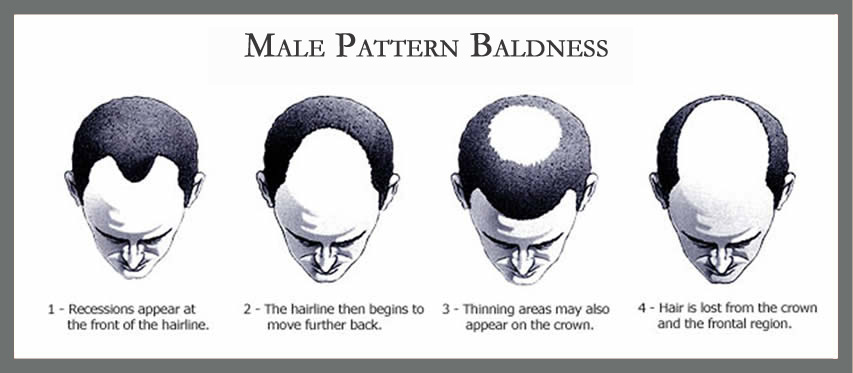Introduction
UFP Hair Restoration specialists see many patients concerned with male pattern baldness. More than 80 percent of men and nearly half of women will experience hair thinning and loss in their lifetime. This condition causes miniaturization of the follicles and is due to underlying susceptibility of hair follicles to circulating androgenic hormones.
Male pattern baldness, also known as androgenetic alopecia, is the most common cause of hair loss in men. It is a hereditary condition characterized by a receding hairline and gradual disappearance of hair from the crown and frontal scalp. Male pattern baldness typically follows a specific pattern, starting with a receding hairline at the temples and thinning of hair on the crown of the head. Over time, the hairline may recede further, and the hair on the crown may become finer, leading to significant baldness.
The primary cause of male pattern baldness is a combination of hormonal and genetic factors. In individuals genetically predisposed to this condition, hair follicles in certain parts of the scalp are sensitive to the hormone dihydrotestosterone (DHT). DHT is derived from testosterone and can shrink hair follicles, making them produce thinner and shorter hairs. Eventually, the affected follicles may stop producing hair altogether, leading to baldness.

When Do Men Start Balding?
Male pattern baldness can start as early as their late teens or early 20s and becomes more common with age. It is influenced by both genetic and hormonal factors, and its severity can vary among individuals. Besides genetics, other factors such as stress, certain medical conditions, and medications may contribute to the progression of male pattern baldness, but they are not the primary cause.
There are various treatments available for male pattern baldness, including medications like minoxidil and finasteride, which can slow down hair loss and promote hair regrowth in some cases. Hair transplant surgery is another option where hair follicles from one part of the body are transplanted into the balding areas.
It's important to note that male pattern baldness is a natural and common part of the aging process, and many men choose to embrace their baldness with confidence. However, for those seeking to address hair loss, consulting a specialized hair restoration expert can provide guidance on available treatment options.
Frequently Asked Questions
Male pattern baldness is both genetic and associated with the male sex hormones called androgens, with dihydrotestosterone (DHT) as the major contributor. DHT affects the hair follicles in susceptible individuals by causing them to shrink and eventually stop producing hair as the follicle becomes dormant.
Common myths about the causes of hair loss include wearing hats, hair products, playing with one’s hair, viral infections, and excess time in the sun. None of these factors have been shown to have any influence on hair loss. Likewise, neither emotional stress nor trauma have been shown to cause male pattern baldness, but it is thought that these factors can accelerate baldness in genetically susceptible individuals.
While male pattern baldness is influenced more strongly by the mother’s genetics, many other genetic factors, including the tendency for baldness on the father’s side are influential in the development of this condition.

Male pattern baldness is diagnosed by evaluating the pattern of hair loss. Your hair restoration specialist will perform a thorough exam and go over your health history with you to rule out any serious medical disorders that could be causing hair loss. Medical conditions are suspected if other symptoms, such as pain, redness, or a rash are involved. If there is any suspicion, a skin biopsy and/or blood test will be ordered to diagnose any conditions that may be responsible for the problem.
Male pattern baldness can begin as early as the teen years but most commonly occurs in adult men and women as they increase in age. The pattern of hair loss typically begins at the temples or the crown of the head. While some men will get a single bald spot others will recede to form an “M” shape.
While clinical psychological effects are uncommon, many men and women who are affected by baldness from any cause find that it can affect many areas of their lives including self-confidence, interpersonal relationships, social and professional endeavors. Fortunately, with advancements in the field of hair restoration, UFP Hair Restoration is able to restore thick, full and natural hair.
Contact Us Today!
Interested in getting treatment for male pattern baldness in Salt Lake City, Draper, Layton, Utah and the surrounding areas? Contact UFP Hair Restoration for more information or schedule a hair restoration consultation with 1 of 3 hair restoration specialists, Drs. Thompson, Henstrom, or Manning at 801.849.8140.